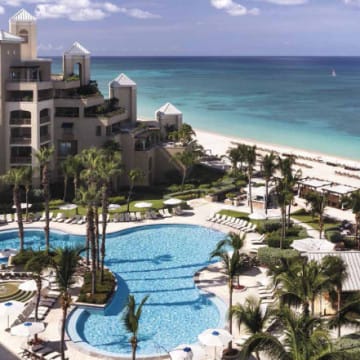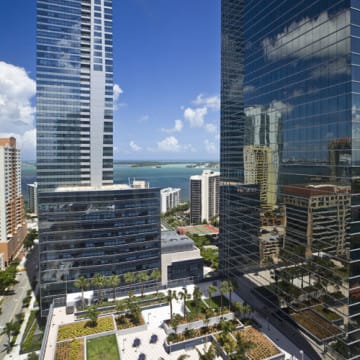South Florida Resort
A world-class resort in south Florida that is being redeveloped by an institutional investor is showing how investments that address climate change risks can also benefit the bottom line with more effective marketing, better financing terms, and lower insurance premiums and energy bills. Key components of this resort’s resilience process have been multiple strategies to prevent damage from risks such as strong winds and storm surges, as well as a disaster recovery plan that allows the resort to recover quickly after an event.
The owner is halfway through a major redevelopment that has focused on upgrades, amenities, and a transition to a resort that includes stateof- the-art meeting facilities. In the early planning stages, the redevelopment took a turn toward resilience when the owner became aware that the property, valued at more than $500 million, was vulnerable to climate change, especially increasingly intense hurricanes and tropical storm surges.
“It became clear to us that, with an asset of this value, it would be very unfortunate if we had a major storm event and lost power and water service to the property,” says the owner’s project manager. After hurricanes, for example, water intrusions and high humidity can cause mold outbreaks within days, and if the air conditioning is not working, all the building finishes could be ruined. If the entire region is hit, rebuilding timelines could be complicated by competition for resources. “We thought it would be prudent to protect the property from incurring substantial storm damage that would take over a year to recover from.”
Mitigating Risks
The resort is designed to withstand a Category 3 hurricane, during which a storm surge could reach an elevation of 16 feet. Whereas the property’s lowest occupied level is at an elevation of 20 feet, the building’s critical infrastructure systems, including the electrical service and central energy plant, were at an elevation of nine feet, making these systems vulnerable. The owner decided to raise the electrical service and to install hurricane-resistant windows, and then the owner kept adding to the list. “Once we started thinking about this, it became very clear that the various aspects of protecting the building were all interrelated,” notes the project manager.
Over the past decade, resilience strategies for the resort have included the following:
- Development of a disaster-recovery plan that provides step-by-step procedures for preparing the site for a storm and for restoring services afterward
- Installation of hurricane-rated windows and doors throughout the property, with largemissile impact-resistant glass on levels up to 30 feet and small-missile impact-resistant glass on levels above 30 feet
- Relocation of the property’s electrical infrastructure to an elevation of 20 feet, well above storm-surge elevation, to protect critical electrical components—switchgears, transformers, and electrical panels. (The new equipment elevation is well above the code requirement of 12.5 feet.)
- Construction of two new electrical service switchgear buildings with generator “quick connects” located above storm-surge elevations
- Procurement of five emergency generators with a capacity of 2,000 kilowatts that are strategically placed after an event to provide electrical service
- Installation of a 20,000-gallon underground diesel fuel tank to run the emergency generators for up to ten days
- Fortification of the central energy plant to provide cooling after a hurricane
- Fortification of the property cooling towers with a steel enclosure to protect from wind and storm-surge debris
- Installation of a piping system between the two central energy plants to maintain cooling under adverse conditions
- Installation of wells for a desalination unit and a 15,000-gallon underground water storage tank for the cooling tower water makeups that also could provide potable water
Creating Value
The owner estimates that its resilience investments boosted the insurable value of the property by 50 percent. The resilience investments have improved the resort’s branding and image, which has been important in the competitive high-end Florida convention business. “Many groups make their plans one to two years in advance, and this resilience gives them the confidence that the facility will be online and available even if there had been a hurricane six months before,” says the project manager.
Resilience measures lowered annual insurance premiums by an estimated $500,000, offering a significant reduction in annual operating expenses. They also have led to immediate energy savings: the impact-resistant windows are energy-efficient low-E rated and are saving approximately $110,000 per year and mitigating the resort’s contribution to global warming. The use of the on-site wells for irrigation reduces the use of city water and saves $75,000 per year.
Resilience strategies have enabled the property to maintain a competitive advantage by reducing the likelihood of building damage, shortening the duration of recovery, and adapting the site to a variety of conditions that would keep the resort operating. The owners also believe they have enhanced access to competitive financing and favorable terms. “What we’ve done is more like what institutions like hospitals and government agencies do for emergency response,” says the project manager. “This is a long-term hold for us, and this asset will stand out because of the resilience put into it.”
“ We thought it would be prudent to protect the property from incurring substantial storm damage that would take over a year to recover from.”
—Project Manager


